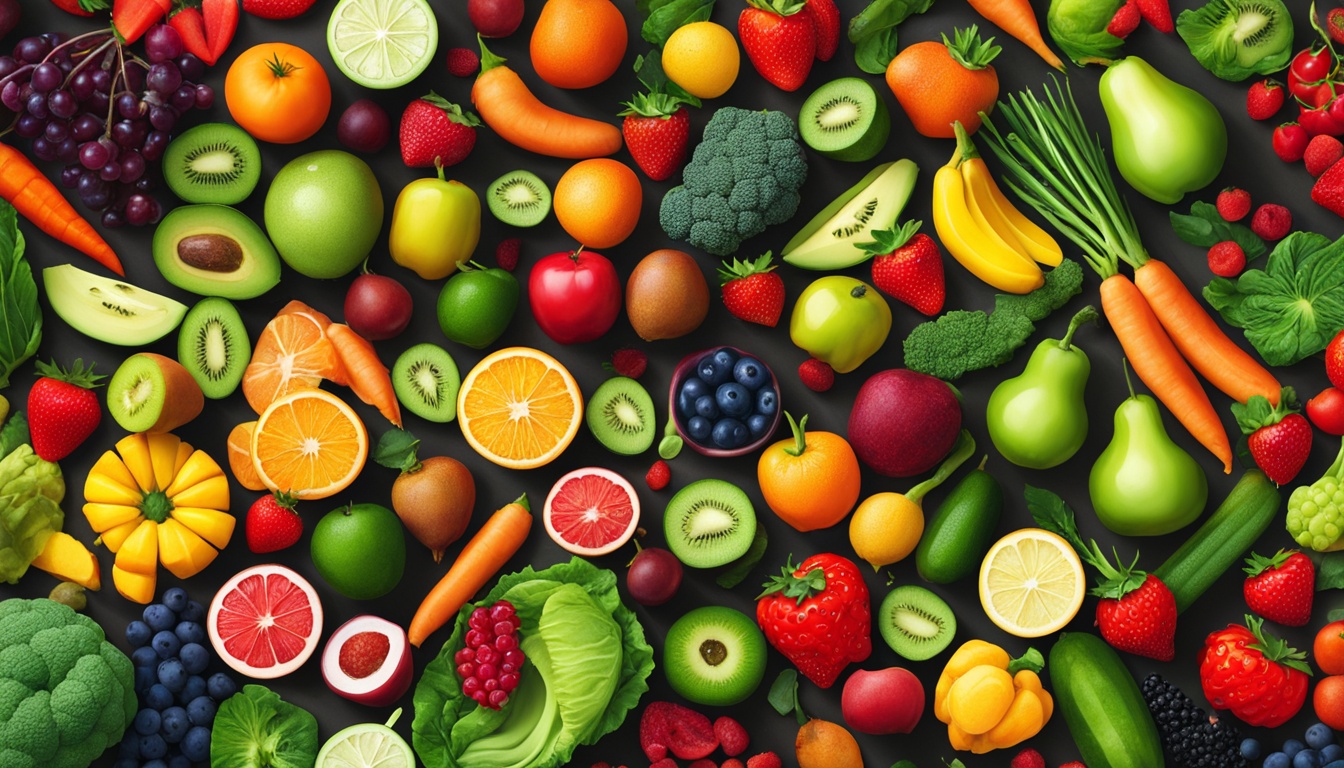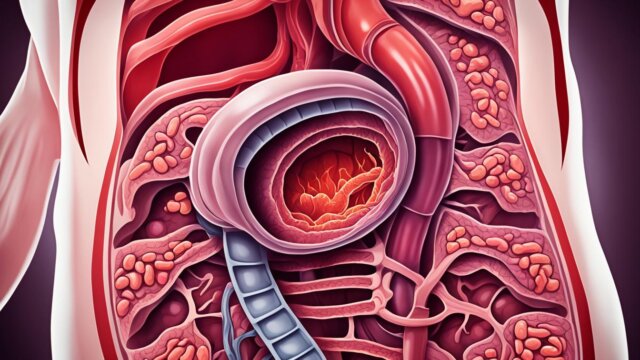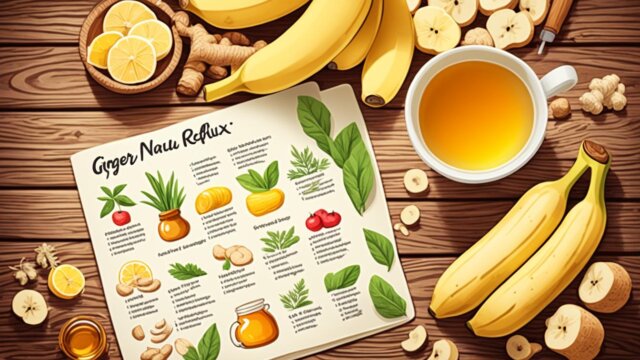FTC disclaimer: This post may contains affiliate links and we will be compensated if you click on a link and make a purchase.
Eating too much bad fat can raise your risk of heart disease and stroke by up to 40%. But, eating lots of fruits and veggies can lower your risk of many health problems. A good diet is key to staying healthy and avoiding long-term health issues.
This guide will cover why a balanced diet is important. We’ll talk about the nutrients your body needs and how to make a healthy eating plan. If you want to lose weight, feel more energetic, or lower your health risks, eating right can help a lot.
Key Takeaways
- A healthy diet focuses on whole, nutrient-rich foods and cuts down on bad fats, sugars, and salt.
- Watching how much you eat and being careful with calories helps with weight management.
- Adding different fruits, veggies, whole grains, lean meats, and dairy gives you important vitamins, minerals, and fiber.
- Reducing bad fats and sugars can lower your risk of heart disease and other health problems.
- Planning and preparing meals can make sticking to a healthy diet easier.
The Importance of a Healthy Diet
Keeping a healthy diet is key for your health. Eating foods full of nutrients helps your body work right and keeps you healthy. The CDC says heart disease is the top cause of death in adults in the U.S. Almost half of U.S. adults have some kind of heart disease. By eating better and moving more, you can cut the risk of heart problems a lot.
Nutrients for Good Health
Eat a mix of foods like cereals, beans, fruits, veggies, and animal products for good health. Foods full of fruits, veggies, whole grains, and low-fat dairy can lower heart disease risk. Not getting enough vitamins A, B, C, E, zinc, iron, and selenium weakens your immune system.
Lowering Disease Risk
Eating lots of veggies and fruits can cut the risk of obesity, heart disease, stroke, diabetes, and some cancers. The National Cancer Institute says eating antioxidants can help prevent cancer. A 2014 study showed eating more fruits can lower the risk of some cancers. A 2016 study found eating high glycemic load diets can make people feel more depressed and tired.
A 2015 study found certain nutrients and foods can help keep your mind sharp and prevent dementia. In 2018, eating foods high in fiber and lean proteins helped people lose weight without counting calories. Eating with family can also be good. In 2018, kids who ate with their families ate more veggies and less sugary foods.
“Eating a portion of oily fish each week can help lower the risk of developing heart disease due to the high levels of omega-3 fatty acids in oily fish.”
Staying at a healthy weight and eating a balanced diet with less saturated fat and more fiber can lower type 2 diabetes risk. Foods high in calcium keep your teeth and bones strong and slow down bone loss. Eating foods like fruits, veggies, whole grains, unsaturated fats, meat, and dairy in moderation can help manage weight and lower the risk of many health problems.
Principles of a Balanced Diet
Getting a healthy diet is key to feeling good. It’s all about eating whole foods full of nutrients. These foods give you the vitamins, minerals, fats, fiber, and calories you need.
Emphasize Whole, Nutrient-Rich Foods
Make sure to eat foods like fruits, veggies, lean meats, fish, dairy, and whole grains. These foods are packed with nutrients. They don’t have the bad sugars, salts, and fats found in processed foods.
Portion Control and Calorie Awareness
It’s important to control how much you eat and know about calories. Eating too many calories can make you gain weight. Eating fewer calories can help you lose weight. It’s best to eat in moderation to avoid health problems.
To control how much you eat, use smaller plates and eat veggies first. Also, try to eat slower. Limit your fat intake to 30% of your daily calories. Keep saturated and trans fats low, and eat less sugar.
Eat whole foods and control your portions to build a diet that’s good for you.
“Eating a balanced diet is not about depriving yourself, but rather about nourishing your body with a variety of wholesome, nutrient-dense foods.”
Weight Management with a Healthy Diet
Keeping a healthy weight is key to feeling good. Eating right can help you manage your weight. By eating fewer calories than you burn, you can lose weight and get healthier.
Creating a Calorie Deficit
To lose weight, you need to eat fewer calories and move more. Women should eat 1,200-1,500 calories a day. Men and active women should aim for 1,500-1,800 calories. Eating less than 800 calories a day is only safe with a doctor’s help.
The Mayo Clinic Diet helps you lose 6 to 10 pounds in two weeks. After that, you can lose 1 to 2 pounds a week until you reach your goal. This diet focuses on making healthy habits for a lifetime.
A typical day on this diet might start with overnight oats and berries, then have Tuscan white bean soup for lunch. Dinner could be sheet-pan roast chicken with veggies and a snack of sliced bell peppers and a banana. You can eat all the fruits and veggies you want to help you lose weight.
Getting 30 minutes of exercise a day is key to losing weight and staying healthy. The diet also suggests doing resistance exercises to burn fat. There are many eating plans to choose from, like the Mediterranean style, to fit your taste and needs. You can even have desserts of up to 75 calories a day for a treat.
Losing weight on this diet can lower your risk of health problems like diabetes and heart disease. It’s a diet that’s easy to follow, fun, and can help you stay healthy for a long time.
As people get older, they might need to eat less or move more to stay at a healthy weight. Losing weight suddenly could mean you have a serious illness. Being overweight can increase your risk of heart disease and diabetes. Being underweight can lead to health problems like osteoporosis and anemia.
Older adults should try to get at least 150 minutes of exercise a week to stay healthy. Eating well and staying active can help you manage your weight and stay healthy. To lose weight, try eating smaller portions, moving more, and choosing healthier foods. To gain weight, eat foods with healthy fats, have more meals, and stay active to increase your appetite.
Essential Food Groups for Health
Keeping a healthy diet means eating a mix of key food groups. These groups give you different nutrients and health perks. They include fruits and veggies, whole grains and beans, and lean meats.
Fruits and Vegetables
Fruits and veggies are packed with vitamins, minerals, fiber, and antioxidants. They include dark greens, red and orange veggies, starchy ones, and beans. You also get them from citrus fruits, berries, and other fruits like apricots and cherries. Try to eat at least 5 servings a day to get what you need.
Whole Grains and Legumes
Whole grains like bread, pasta, and rice give you complex carbs, fiber, and plant protein. Legumes, like beans and lentils, are great for plant protein and fiber too. These foods should be a big part of your diet.
Lean Proteins
Lean proteins from poultry, fish, eggs, and beans help with muscle health and growth. Try to eat fish twice a week, with one type being oily. Also, keep red or processed meat to less than 70g a day.
Food Group | Examples | Recommended Intake |
|---|---|---|
Fruits and Vegetables | Dark green, red/orange, starchy, legumes, citrus, berries, tree fruits | At least 5 portions per day (80g per portion) |
Whole Grains and Legumes | Bread, pasta, cereal, rice, oats, beans, peas, lentils | Just over a third of the diet |
Lean Proteins | Poultry, fish, eggs, beans | Two portions of fish per week, with one being oily fish; limit red/processed meat to 70g per day |
By eating a mix of these foods, you make sure your diet is balanced. This gives you the nutrients you need for good health and happiness.

“Eating a healthy, balanced diet is one of the most important things you can do to protect your health and well-being.”
Limiting Unhealthy Fats and Sugars
To stay healthy, it’s key to eat less unhealthy fats and sugars. Eating too much saturated and trans fats can raise your risk of heart disease and stroke. Switching to unsaturated vegetable oils can help you eat more healthy fats.
Also, eating less added sugars, which should be less than 10% of your calories, is good for you. Studies link eating foods with added sugars to eating more calories than those who eat less added sugars. Cutting down on added sugars, like in sweet drinks, helps keep a healthy weight.
- A 30-gram serving of reduced-fat chocolate chip cookies has 118 calories, while the regular version has 142 calories for the same serving size.
- A one-ounce serving of baked tortilla chips has 113 calories, whereas regular tortilla chips have 143 calories for the same serving amount.
- A two-tablespoon serving of fat-free caramel topping contains 103 calories, the same as an equal amount of homemade caramel topping with butter.
- Fat contains twice as many calories as protein or carbohydrate, emphasizing the importance of reducing fat for energy balance.
Added sugar gives calories but no extra nutrients, making it vital to choose nutrient-rich foods. Giving kids fat-free or low-fat milk instead of sugary drinks helps with calcium needs. This is crucial for strong bones and teeth in kids and teens, especially girls.
“Less than 30% of total energy intake should come from total fat to prevent unhealthy weight gain. Saturated fats should be less than 10% of total energy intake, and trans fats should be less than 1% of total energy intake.”
By using these tips and choosing nutrient-rich foods, you can cut down on unhealthy fats and sugars. This supports your overall health and well-being.
Meal Planning and Preparation Strategies
Planning and preparing meals can help you eat healthier. Many people pick fast food because they’re busy. This leads to eating more calories, which can make you gain weight. But, planning your meals ahead can help you control what you eat and stay healthy.
It can also save you time and money. You won’t have to decide what to eat or rush to make dinner.
Make a Grocery List
Set a special day each week for meal planning, shopping, and prep. This makes it easier to stick to a healthy diet. Over 75% of people struggle with eating healthy because cooking feels hard. Making a list before you go shopping helps you avoid buying unhealthy foods.
Cooking at Home
Cooking at home lets you control what goes into your food. This can lead to eating healthier. Planning your meals can cut your daily calorie intake by 400-600 calories. About 70% of people who plan their meals save time and money on food.
It’s important to store food right. Keep cooked meat and poultry in the fridge for 3-4 days. Cooked beans and hummus can last 5 days. Hard-boiled eggs and chopped veggies can stay fresh for a week in the fridge.
Freezing is good for many foods. Soups and stews can last 2-3 months. Cooked meats can last 3-6 months. Vegetables can be frozen for up to a year if blanched first.
There are many recipes that are great for meal prep. Try making Farro with Confetti Vegetables or Cauliflower Tomato Soup. Start with planning two to three meals a week to get the hang of it.
The Create Your Plate method suggests a balanced meal with 25% protein, 25% carbs, and 50% veggies. Cooking meals in bulk can help reduce food waste and give you meals for the week.
Snacking with portion control can also help you eat less overall. Prepackaged string cheese is a good choice for a quick snack.
Getting your family involved in meal planning can make eating healthier more fun. It can also help kids try new foods. Spending two hours a week on meal planning can make a big difference in your health.

“Meal planning is key for a healthy diet. It helps you eat a variety of foods every day.”
Older adults should eat a variety of foods to stay healthy. The USDA offers different food patterns to follow. The MyPlate Kitchen has recipes for different ages and activity levels.
Planning your meals can help you eat the right amount for your body. It’s good to talk to your doctor about your diet. Using budget-friendly foods can make meal planning easier and save money.
Drinking enough water is important for staying hydrated and digesting food. Try to use less salt and avoid sugary drinks for better health.
Mindful Eating Habits
Adding mindful eating habits to your life can change how you eat for the better. Mindful eating means eating with full attention. It’s about enjoying each bite and listening to your body’s hunger and fullness signals.
Eat Slowly and Savor Your Food
Eating slowly is a big part of mindful eating. It takes about 20 minutes for your brain to know you’re full. By eating slowly, you can feel when you’re full. This helps with portion control and satiety. A study found that 34 women lost about 4 pounds after 12 weeks of mindful eating.
Enjoying your food’s flavors, textures, and smells makes eating better. This way of eating makes you happier with your meals. It also helps you know when you’re hungry or full.
“Mindful eating is the practice of paying attention to the present moment, without judgment, while eating. It’s about engaging all of your senses, savoring each bite, and letting your body’s natural signals of hunger and fullness guide your eating.” – Healthline
It might take time to get the hang of mindful eating, but it’s worth it. Many studies show it helps with weight loss and better health. By eating slowly and enjoying your food, you can build a healthier relationship with eating. This supports a balanced, healthy diet.
Dietary Guidelines for Special Populations
Healthy eating is important for special groups like pregnant and breastfeeding women, and kids and teens. These guidelines help meet their unique needs and support their growth. They make sure everyone gets the nutrients they need for good health.
Pregnancy and Breastfeeding
Eating right is key for moms and babies during pregnancy and breastfeeding. Moms should eat lots of fruits, veggies, whole grains, lean meats, and healthy fats. This helps the baby grow strong and keeps the mom healthy too.
It’s important to get enough folic acid, iron, and calcium during these times.
Children and Adolescents
Kids and teens need a balanced diet for growth and to build healthy habits. Eating a mix of foods from each group helps prevent diseases like high blood pressure and diabetes. It’s also good to limit sugary foods, bad fats, and too much salt.
By giving special diets to these groups, we help them grow and stay healthy. This way, moms and their kids can live healthier lives.

Superfoods and Healthy Swaps
Adding superfoods and healthy swaps can make your diet better. Superfoods like berries, leafy greens, and nuts are full of vitamins and antioxidants. They are great for your health. Swapping things like whole grains for refined carbs or unsweetened water for sugary drinks can also boost your diet’s quality.
Nutrient-Dense Superfoods
Superfoods are known for their high nutrient levels and health benefits. Here are some top superfoods to think about:
- Almonds: A 2021 review found they help with weight loss and support gut health.
- Chia seeds: These give you 11 grams of fiber per ounce, plus magnesium and manganese.
- Walnuts: They are full of fiber and important vitamins and minerals.
- Salmon: This oily fish is packed with protein, omega-3s, and vitamin D.
- Sardines: Full of nutrients like calcium and vitamin D.
- Shrimp: It’s low in fat but high in protein, selenium, and vitamin B12.
Healthier Substitutions
Swapping foods can make your diet much better. Here are some good swaps:
- Go for whole grains like brown rice instead of refined carbs. Brown rice has fiber, vitamin B1, and magnesium.
- Use oats for their nutrients and beta-glucans, which help with cholesterol and gut health.
- Add quinoa, a fiber and magnesium-rich grain that’s great for plant-based protein.
- Choose ghee over butter or coconut oil for its less saturated fat content of about 66%.
- Switch sugary drinks to unsweetened sparkling water or infused water for a healthier choice.
By choosing nutrient-rich superfoods and making smart swaps, you can make your diet better. This supports your health and well-being.
“The key to a healthy diet is not deprivation, but rather the mindful incorporation of nutrient-rich foods that nourish your body and soul.”
Healthy Diet for Weight Loss
Choosing a healthy diet is a great way to lose weight for good. You can do this by eating fewer calories, moving more, or both. Aim to eat 600kcal less each day. Men should aim for 1,900kcal, and women for 1,400kcal.
Eating foods full of nutrients and controlling how much you eat helps with weight loss and staying healthy. Diets like the Mediterranean, DASH, MIND, and Nordic diets are good for losing weight and staying healthy. They can lower the risk of heart disease, diabetes, depression, and memory loss. Intermittent fasting and the ketogenic diet also help with weight loss by changing how your body works.
Here are some tips to help you lose weight:
- Eat a balanced, nutrient-rich diet. Use the Harvard Healthy Eating Plate model. Fill half your plate with whole grains and healthy protein, and the other half with vegetables and fruits.
- Focus on satiating foods. Choose protein-rich breakfasts like eggs and whole grains. Add vegetables, soups, and snacks like chia seeds to stay full.
- Manage portion sizes. Use smaller plates and measure ingredients. Avoid extra helpings to keep calories in check.
- Incorporate mindful eating habits. Don’t eat while watching TV or on your phone. Listen to your body’s hunger and fullness signals.
Changing your diet and eating habits can help you reach your weight loss goals. It also keeps your body healthy. For more help, try the free NHS Weight Loss Plan. It’s a 12-week program that helps with setting goals, meal planning, and making healthier choices.
Overcoming Barriers to Clean Eating
Starting a clean eating lifestyle can be tough. It’s hard to find time for meal planning and preparation. Keeping a good mindset and staying motivated is also key to success.
Meal Prep and Planning
One big challenge is the time needed for meal prep and planning. But, having a routine helps a lot. Try to set aside a few hours on the weekend to plan meals, prep ingredients, and pre-cook dishes. This keeps you on track and makes healthy food easy to grab.
Also, keep your kitchen full of whole foods. This makes making healthy meals quick and easy. It also helps you avoid ultra-processed foods.
Mindset and Motivation
Keeping a positive mindset and staying motivated is key. Set realistic goals and celebrate your wins. Don’t think you have to be perfect, and allow some treats. This stops feelings of being too hard on yourself.
Having a supportive network of family and friends who care about health is great. Look for online groups or local clubs for support and to stay on track.
Remember, changing your diet and lifestyle takes time and patience. Focus on meal prep and a positive mindset. This way, you can beat the challenges of clean eating and reach your health goals.
The Role of Exercise in a Healthy Lifestyle
Keeping fit is more than just eating right. It also means being active. Exercise is key for staying healthy and has many benefits beyond just managing weight.
The U.S. Department of Health and Human Services says adults need 150 minutes of moderate activity or 75 minutes of hard activity each week. It’s also good to do strength training twice a week for all major muscles.
Exercise can prevent or help manage many health issues. This includes stroke, metabolic syndrome, high blood pressure, type 2 diabetes, depression, anxiety, some cancers, arthritis, and falls. It also makes you feel happier and less stressed by releasing certain brain chemicals.
Exercise helps you sleep better too. It makes falling asleep easier and improves sleep quality. For men, it can also lower the risk of erectile dysfunction.
Working out can be fun and a chance to meet people. It lets you enjoy the outdoors or do things that make you happy. Mixing up your activities helps keep you on track with a healthy lifestyle.

For a balanced life, mix eating right with regular exercise. Adding exercise to your daily life brings many benefits. It helps you take charge of your health and well-being.
Healthy Diet: Benefits, Plan, Foods and Tips
Following a healthy diet has many benefits for your health. Eating whole, nutrient-rich foods and eating mindfully helps your body. It also helps you manage your weight and lower the risk of chronic diseases. A balanced diet plan is key to reaching your health goals.
At the heart of a healthy diet is eating a mix of fruits, veggies, whole grains, lean proteins, and healthy fats. Proper meal portions and controlling calories help with weight management. Also, eating less unhealthy fats and sugars and planning meals well boosts a healthy diet’s benefits.
Adding superfoods and healthier food choices to your meals makes your diet more nutritious. Foods like omega-3-rich fish and fiber-rich whole grains give you important vitamins and minerals. These support your health and well-being.
Eating mindfully, like eating slowly and enjoying your food, is key. Being present at meals helps you know when you’re hungry or full. This leads to better eating habits.
A healthy diet isn’t the same for everyone. It’s important to make your eating plan fit your needs, likes, and health goals. By looking at your diet, setting achievable goals, and following these healthy tips, you can start a journey to better health.
Creating a Personalized Healthy Eating Plan
Creating a healthy eating plan that fits you is key to success. Start by looking at your current eating habits. Check your food choices, how much you eat, and what nutrients you get. It’s important to know the difference between serving and portion sizes to make a plan that fits your calorie needs.
Assessing Your Current Diet
Look at your diet to see where you can do better. Think about the foods you eat, how often you eat out, and your nutrient levels. Keeping a food diary helps you track your eating and see if your diet plan works.
Setting Realistic Goals
After assessing your diet, set goals that match your health goals. Goals could be eating more veggies, cutting down on sugar, or eating fewer calories for weight loss. Make sure your goals are doable and lasting. Start with small, easy changes to make healthy eating a habit.
A good eating plan isn’t about quick fixes or cutting out foods. It’s about finding a balance that feeds your body and fits your likes and needs. By looking at your diet and setting realistic goals, you can make a plan that helps your health.
“The key to long-term dietary success is finding an approach that you can sustain for life, not just until you reach your goal weight.”
- Identify your current eating habits and areas for improvement.
- Set specific, measurable goals that align with your health objectives.
- Incorporate gradual, sustainable changes to build lasting healthy habits.
- Seek support from friends, family, or online communities to stay motivated.
By making a personalized healthy eating plan, you can feed your body, reach your goals, and enjoy nutritious foods for life.
Resources for Healthy Eating
Having good resources can really help with a healthy diet. You can find everything from official nutrition advice to lots of recipes. These tools can help you eat better.
Nutritional Guidelines
Looking at government dietary guidelines is a good start. They give clear advice on what foods to eat and how much. Most people need to eat more fiber, calcium, vitamin D, and potassium, says the Dietary Guidelines for Americans, 2020–2025.
It’s also key to eat less sodium, sugar, and bad fats for health. Following these guidelines helps meet your body’s needs.
Recipe Sources
Recipe websites, cookbooks, and apps can give you lots of ideas for healthy meals. They have many recipes that are tasty and full of nutrients. You can learn to shop for fresh, whole foods more often.
This way, you can try new foods and eat better. It’s a great way to take care of your health.
Nutritional Guidelines | Recipe Sources |
|---|---|
|
|
“Eating a healthy, balanced diet can have a profound impact on your overall well-being. By utilizing the right resources, you can take control of your nutrition and make sustainable changes that benefit your body and mind.”
Using both official advice and creative recipes can help you make good food choices. Start looking into these resources now. They can lead you to a healthier life.
Conclusion
Following a healthy diet is key to staying well and avoiding long-term illnesses. Eating whole, rich foods, watching how much you eat, and eating mindfully helps. This way, you can meet your health and weight management goals. Adding regular exercise, getting past hurdles, and using resources can make your healthy lifestyle even better.
Creating a diet that fits you can lead to lasting health gains. , Studies show that what we eat affects our health. Foods can lead to heart disease, high blood pressure, obesity, cancer, weak bones, diabetes, and more. Eating right can help you stay healthy and feel good.
A healthy diet is more than just losing weight. It’s about making your life better and cutting down on long-term health risks. By using these healthy diet tips, you start a path to a happier, healthier life. ,
FAQ
What are the benefits of a healthy eating plan?
A healthy eating plan gives your body the nutrients it needs. It also helps you stay within your daily calorie goal for weight loss. Plus, it lowers your risk for heart disease and other health issues.
What are the key components of a healthy, balanced diet?
A healthy diet focuses on veggies, fruits, whole grains, and low-fat dairy. It includes lean meats, poultry, fish, beans, eggs, and nuts too. It limits bad fats, sodium, and sugars, and watches portion sizes.
How can a healthy diet help with weight management?
To lose weight, you need to eat fewer calories and move more. Women should aim for 1,200-1,500 calories a day. Men and active women should aim for 1,500-1,800 calories.
What are the essential food groups for a healthy diet?
A healthy diet has many food groups. These include fruits and veggies, whole grains and legumes, and lean proteins. They give you the nutrients you need for good health.
How can I limit unhealthy fats and sugars in my diet?
To eat healthy, cut down on bad fats like saturated and trans fats. These fats can harm your heart. Use healthy oils and eat less sugar for better health.
What are some effective meal planning and preparation strategies?
Plan your grocery list before shopping and cook at home more. Eating mindfully can also help you stick to a healthy diet and manage your weight.
How can I incorporate nutrient-dense superfoods and healthier substitutions into my diet?
Add superfoods like berries, leafy greens, and nuts to your meals. Choose whole grains over refined carbs for a healthier diet.
What are some resources available to support a healthy eating lifestyle?
Use government dietary guidelines and check out recipe websites and cookbooks. Meal planning apps can also help you follow a healthy diet.








